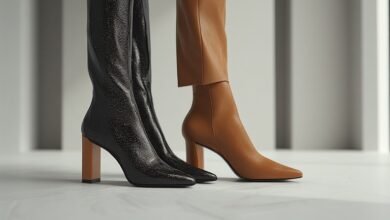Sustainable & Eco-Friendly Footwear
The fashion industry has long been criticized for its environmental footprint, but in 2025, footwear brands are stepping up—literally. Sustainable and eco-friendly shoes have transitioned from niche products to mainstream must-haves. From sneakers made of recycled plastics to sandals crafted with plant-based materials, eco footwear is reshaping the industry. But how do they compare to traditional footwear in terms of style, durability, and affordability? Let’s take a closer look.
Why Sustainability Matters in Footwear 🌍🛠️
The footwear industry produces millions of pairs each year, much of it ending up in landfills. Traditional shoes often rely on leather, synthetic rubber, and plastics—all materials with a heavy carbon footprint. Eco-friendly footwear, on the other hand, uses recycled, plant-based, or biodegradable materials designed to reduce waste and pollution.
👉 Traditional footwear = fast, functional, but harmful.
👉 Eco footwear = slower, mindful, and future-focused.
Materials: Innovation at Its Core 🧵🌱
- Traditional Footwear: Relies on leather, polyester, and petroleum-based soles. These materials are durable but contribute to deforestation, pollution, and waste.
- Sustainable Footwear: Brands are using innovative alternatives such as:
- Recycled ocean plastics for sneakers.
- Pineapple leather (Piñatex) for boots and bags.
- Cork, hemp, bamboo, and algae-based foam for soles.
👉 The material shift not only reduces impact but also tells a story of innovation that resonates with conscious consumers.
Style & Aesthetic Appeal 👟✨
There was a time when eco-friendly shoes looked plain or “too earthy.” In 2025, that’s changed dramatically.
- Traditional Shoes: Offer endless variety, often prioritizing aesthetics over environmental impact.
- Eco Footwear: Now rivals mainstream brands with stylish designs, from sleek minimalist sneakers to bold statement heels made with recycled components.
👉 Sustainability no longer sacrifices style for ethics—it merges them.
Durability & Performance 🏃♂️⚡
- Traditional Footwear: Known for long-lasting wear, especially leather and high-performance athletic shoes.
- Eco-Friendly Footwear: Early versions struggled with durability, but now, thanks to material innovation, many sustainable shoes perform just as well. For example, recycled plastic uppers are surprisingly resilient, while natural rubber soles provide comfort and flexibility.
👉 The performance gap between eco and traditional footwear is rapidly closing.
Price Point: Affordable or Premium? 💰♻️
- Traditional Shoes: Available at every price range, from budget to luxury.
- Eco Footwear: Often priced higher due to innovative materials, ethical labor practices, and smaller-scale production.
👉 While sustainable shoes may cost more upfront, they offer long-term value—both for the planet and personal conscience.
Trendsetters in the Market 🌟👣
- Allbirds: Famous for wool runners and plant-based foams.
- Rothy’s: Stylish flats and sneakers made from recycled water bottles.
- Adidas x Parley: Mainstream collab using ocean plastics for high-performance sneakers.
- Veja: Minimalist sneakers with organic cotton and wild rubber.
These brands have blurred the line between eco niche and mainstream style.
Consumer Mindset in 2025 🧑🤝🧑🌱
Today’s shoppers want more than fashion—they want purpose-driven products. Gen Z and millennials, in particular, are fueling the eco footwear boom by demanding brands that prioritize sustainability without compromising aesthetics. Social media platforms like TikTok and Instagram amplify this trend, making eco sneakers just as desirable as high-fashion drops.
👉 Conscious shopping is no longer a trend—it’s becoming the default mindset.
Strengths & Limitations ⚖️
- Sustainable Footwear:
✅ Eco-conscious, innovative, stylish.
❌ Often higher in price, limited availability in some regions. - Traditional Footwear:
✅ Affordable, widely accessible, established durability.
❌ Environmentally harmful, ethically questionable production.
👉 Eco footwear offers value with responsibility, while traditional footwear prioritizes scale and affordability.
The Future of Footwear 🌟♻️
Sustainable footwear is no longer just a “green alternative.” It’s becoming a new standard. With luxury brands like Stella McCartney and mainstream players like Nike and Adidas investing in eco materials, the future of footwear is innovative, stylish, and sustainable by default.
Final verdict: If traditional shoes represent the past, eco-friendly footwear represents the future of fashion—a future where style, comfort, and sustainability walk hand in hand. 🌱👟✨



